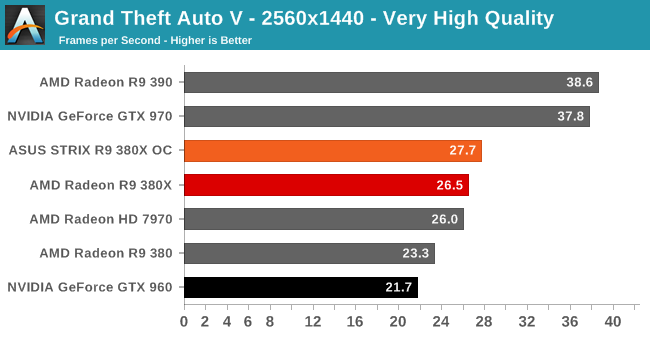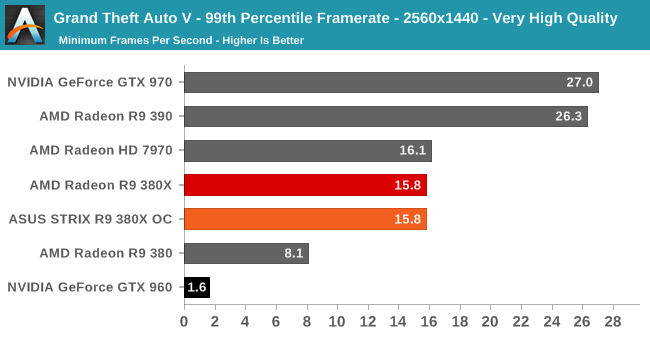The AMD Radeon R9 380X Review, Feat. ASUS STRIX
by Ryan Smith on November 23, 2015 8:30 AM EST- Posted in
- GPUs
- AMD
- Radeon
- Asus
- Radeon 300
Grand Theft Auto V
The open world action game in our benchmark suite is also the last game in our suite: Grand Theft Auto V. The latest edition of Rockstar’s venerable series of open world games, Grand Theft Auto V was originally released to the last-gen consoles back in 2013. However thanks to a rather significant facelift for the current-gen consoles and PCs, along with the ability to greatly turn up rendering distances and add other features like MSAA and more realistic shadows, the end result is a game that is still among the most stressful of our benchmarks when all of its features are turned up.
On a quick note about settings, as Grand Theft Auto V doesn't have pre-defined settings tiers, I want to quickly note what settings we're using. For "Very High" quality we have all of the primary graphics settings turned up to their highest setting, with the exception of grass, which is at its own very high setting. Meanwhile 4x MSAA is enabled for direct views and reflections. This setting also involves turning on some of the advanced redering features - the game's long shadows, high resolution shadows, and high definition flight streaming - but not increasing the view distance any further.


Grand Theft Auto V is another game that punishes 2GB cards to a degree, which plays into the R9 380X’s favor. At 1080p this helps to keep the card 11% ahead of the GTX 960 and 5% ahead of the R9 380. That said, GTA is the one game where perhaps even the R9 380X isn’t powerful enough for no-compromises 1080p gaming, and while 38fps is more than playable (this was a 30fps console game), the 60fps PC standard will require giving up MSAA to hit that mark.


Meanwhile the 99th percentile framerates further drive home the point about 2GB cards being insufficient. However it also points out how even the R9 380X can’t stay above 30fps at all times, reiterating what we said above about possibly needing to drop MSAA to get the best 1080p performance on the R9 380X.










101 Comments
View All Comments
godrilla - Monday, November 23, 2015 - link
Newegg has the PowerColor r9 390 for $265.99 preblackfriday deal, for a bit more you get 20% more performance and double the vram!r3loaded - Tuesday, November 24, 2015 - link
Good to see my 7970 is still holding up very well even after almost four years!Enterprise24 - Tuesday, November 24, 2015 - link
7970 from 2011 can still compete with 380X in 2015.CiccioB - Tuesday, November 24, 2015 - link
Even the GTX480 can compete with GTX750Ti... something to be proud of, isn't it?evilspoons - Tuesday, November 24, 2015 - link
Ah, I'm still undecided what to do with respect to replacing my SLI GTX 680s. I'm in Canada so we're getting murdered by the exchange rate (GTX 970 is $380-$450, R9 390 is $450, the first R9 380X cards are $330...).Guess I'll just hold on to my 680s a while longer.
Mugur - Wednesday, November 25, 2015 - link
I don't think that 380x is a bad card, by any means. It just needs to replace 380 4GB in that price slot and/or the OEMs to bin 380 with only 2 GB of RAM and let the 4G only for 380x. Currently, although understandable for the "novelty" factor, I saw in my country the Asus 380x Strix OC with the same price that some (discounted or not) GTX 970 or R9 390 cards (including an Asus Strix 970 OC :-) ) which is hilarious. Also with like 50% more than a Sapphire Nitro 380 4GB that I bought on Black Friday. Or AMD could simply replace 380 with 380x if the yields are good enough...SolMiester - Wednesday, November 25, 2015 - link
LOL, bit late to the party isnt it, anyone buying mid range has probably already purchased this generation...aria - Monday, November 30, 2015 - link
I'm not sure I agree. I'm still rocking an HD 7750 (perhaps "wheeling," as in "wheelchair" might be more appropriate at this point). It was mid-tier when I got it, but now it's not really sufficient. I'd like to play games at 1920x1080, but i don't really care; 1360x768 is good enough for me. But my current card can't even deliver that at 60 fps any longer (I actually think the card has deteriorated, because I played Dragon Age Inquisition last year on decent settings, and now I can't run it at 15 fps on Low and 1024x768). Anyway, most people using mid-tier I imagine are more like me. We don't purchase an upgrade as soon as one is available--we want to get the highest mid-tier we can, which involves waiting. If I'd replaced my 7750 two months ago, today I would have an inferior mid-tier card, which certainly will become important a year from now when I'm trying to get just a bit more performance out of it. 10% doesn't matter today, but 18 months from now that 10% will mean the difference between playable and unplayable. The rules of high end gaming aren't applicable at the mid-tier range, because we don't buy an upgrade simply because it's an upgrade.HollyDOL - Thursday, November 26, 2015 - link
Another proof graphics industry badly needs new manufacturing process. Possibilities of what can be achieved at 28nm (GPU wise) seem to be exhausted. It will get interesting with new process + HBM2, until then it's going to be a stall water.lazymangaka - Tuesday, December 1, 2015 - link
Unless someone was able to snag the 380X at a significant discount, I would have trouble justifying not spending the extra money to jump to the 390. That really looks like it would be $60 well spent.